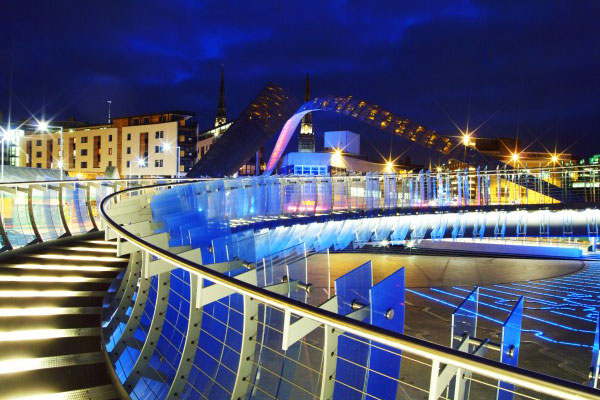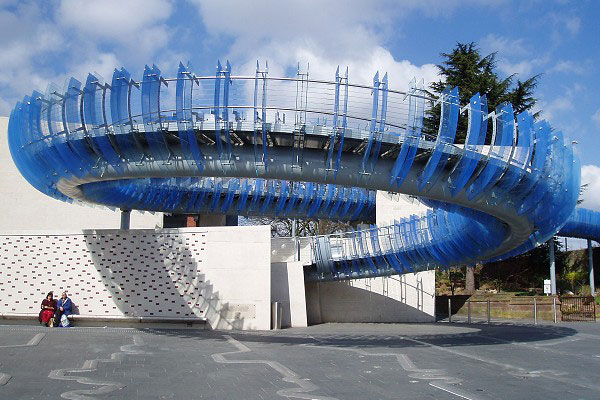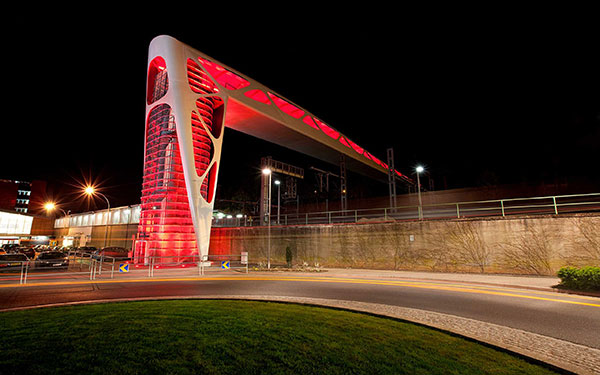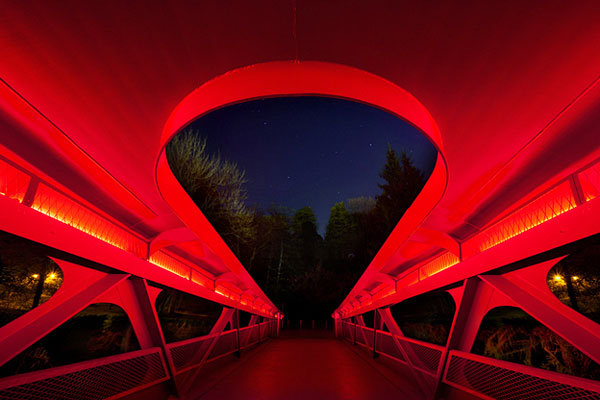The first part of a look at contemporary European footbridges…
Over the past decade a wealth of urban regeneration schemes across Europe have completely changed the urban landscape by reconquering former brownfield sites, cleaning up riverways and creating pedestrian links and cycle paths. Very often these projects required creating new light pedestrian footbridges to link up different parts of the city across existing transport infrastructure which opened up a new field of design for architects within the built environment. Many of these footbridges have become architectural showpieces in their own right that show what can be achieved today with computer aided design and light weight modern materials. Across the two posts (Part 1 and Part 2) we look at four examples across Northern to Southern Europe and which span from the beginning of the millennium to 2011.

Whittle arch and Glass bridge, as part of the Phoenix project, Coventry.
Designed by MacCormac Jamieson Prichard (MJP Architects) with glass artist Alex Beleschenko
The Whittle Arch and Glass Bridge
In Coventry the Phoenix Initiative was the name given to Coventry City Council’s Millennium scheme. Coventry has risen from the ashes a number of times since the war but this large scale regeneration project aimed at creating a direct pedestrian route from the cathedrals area to Millennium Place adjacent to the Museum of British Road Transport. The brief was to connect the historic core around the cathedrals with the activity that epitomized 20th century Coventry, namely cars. A series of four spaces was conceived cascading down a once natural hillside, now terraced by the earlier medieval buildings. When the project began in 1997 these four spaces were occupied by a road junction and different buildings including a multi-storey car park.
The Whittle Arch is a dramatic twin-arch tubular structure that provides a focal point to the whole Millennium Place development. It is named after and commemorates Sir Frank Whittle, the pioneer of the jet engine, who was born in Coventry. In the footsteps of Whittle the arch uses technology to design the arch’s geometry. Spanning 60m across a service road, the arches are formed of aerofoil section tubular lattices, clad with perforated stainless steel sheathing. The arches are fabricated from standard circular hollow steel sections that span between plated diaphragms. One set of tubes span directly between the diaphragms to carry the axial thrusts and bending moments, another forms a series of spirals between the diaphragms and these carry the shear forces and torsions that exist under the different load cases. The arches lean together supporting each other through a single connection point at the crown approximately 15m above the ground. At night the structure is illuminated from within the steel mesh cladding.
Constructed adjacent to Coventry’s Transport Museum and just a few metres from the Whittle Arch, the Glass Bridge rises in a spiral to take pedestrians up and over a surviving remnant of a medieval city wall and across the restored Lady Herbert Garden before arriving in the garden of International Friendship. The bridge takes its name from the glass fins which envelope the parapets but the structure is actually predominantly constructed of steel. The bridge and ramp structure is formed of a simple 762mm diameter tube that is pre-bent to the various radii needed to form the profile of the bridge. Tubular steel columns, irregularly positioned to avoid features beneath the bridge, support the tube. An intricate steel deck and balustrade system with coloured glass fins guides pedestrians to their destination.

Glass bridge, Coventry. Image by LUSAS.
The bridge was designed by MacCormac Jamieson Prichard (MJP Architects). Manufactured by Rowecord it is 130m long in total long in total, curving gently from the east before descending in a dramatic 15m diameter spiral ramp at its west end. Some 40m of the bridge is unsupported at this end, subject to substantial bending and torsional effects. These are resisted by a 762mm diameter hollow steel tube, which forms the primary structural member for the entire bridge. Vibrations are prevented by the presence of three tuned mass dampers inside the tube.
The deck system comprises a series of anti-slip “planks” separated by grilles at frequent intervals. This serves a dual purpose: lighting is hidden below, and at night the deck lights up as a series of stripes, requiring no further illumination. It also allows the deck to drain freely, rather than having to capture surface water run-off at one end, which would be a challenge for such a long bridge.
Esch-sur-Alzette, Luxembourg

Footbridge connecting the city centre and Galgenberg Park, Esch-sur-Alzette, Luxembourg
Esch-sur-Alzette is Luxemburg’s second largest city and holds a strong industrial heritage from its former steel and coal mining activities. The city wants to move away from its industrial past to provide a more attractive urban setting. This very striking footbridge provides a direct link between the heart of the city and the new Galgenberg Park which has become a new urban focal point with its gardens, sports facilities and an animal park.
From a technical standpoint the site conditions made it quite a complex foot bridge to install because it crosses over a busy railway line where rail traffic is uninterrupted. It spans across a distance of over 100m and rises up to a height of 21m to go over several overhead high voltage power lines. From an aesthetic point of view the footbridge creates an intriguing and spectacular landmark, which seems to float between the two worlds. The overall volume is characterized by a simple and minimalist design that contrasts with its chaotic environment (power lines, bus platforms, trains, roads and roundabouts etc.). The entire bridge is conceived as a homogeneous steel skin. Its complex steel structure is made up of seven prefabricated sections that were assembled step by step on temporary steel scaffolding to span across the railway lines onto the edge of the park. Once completed the footbridge rests on a concrete pillar on the park side and two steel legs on the city side whose width provides the required stability to resist against the prevailing winds. To create a smooth floor surface a layer of lightweight concrete with a polyurethane resin finish was added.

Red-painted interior of footbridge, Esch-sur-Alzette. Photo by Steve Troes Fotodesign, Fabrizio Maltese Photography.
Whereas the exterior shell of the footbridge is painted pale grey, emphasizing the subtle curves of its external shell, the inside is painted bright red – this is partly a reference to the region’s characteristic red soil but also a way of highlighting this new pedestrian running directly from the city center to the green recreational area. For the pedestrian walking through, this bright red interior it feels like being in a warm and cosy cave or a giant’s belly. The footbridge’s external appearance changes according to the time of day and the weather. During daytime, when the weather is nice, its pale grey dress and rounded shapes stand out against the dark woods beyond. On a cloudy day, the bridge is more subdued in order to merge with the sky. But it is at night time that the footbridge stands out most: with the spotlights at its feet and the LED lighting inside it makes the whole structure glow red from inside.